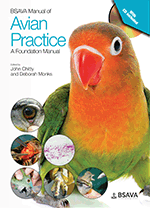
Full text loading...

Surgery is an integral part of day-to-day veterinary practice. The popularity of pet birds means that more requests than ever are being made for advanced veterinary care. This chapter provides clinicians with information and guidance on selected soft tissue surgical procedures that may be encountered in pet avian practice.
Basic surgery, Page 1 of 1
< Previous page | Next page > /docserver/preview/fulltext/10.22233/9781910443323/9781910443323.17-1.gif

Full text loading...
















































